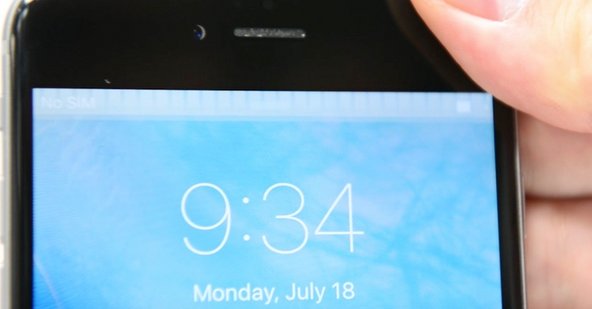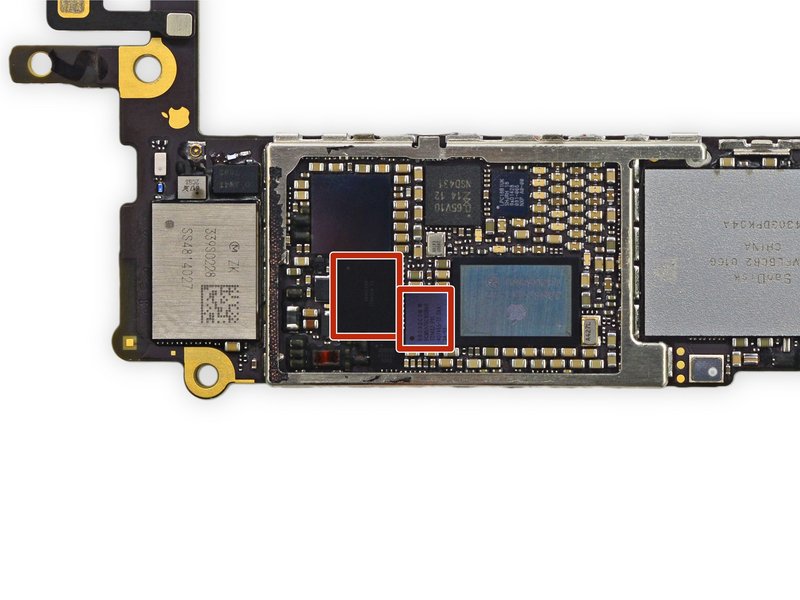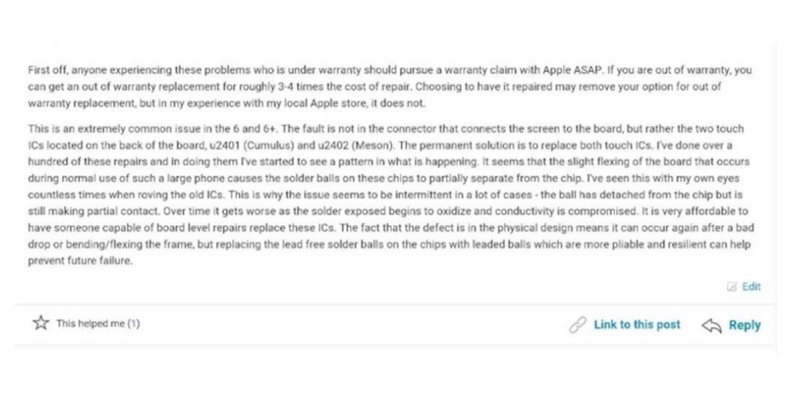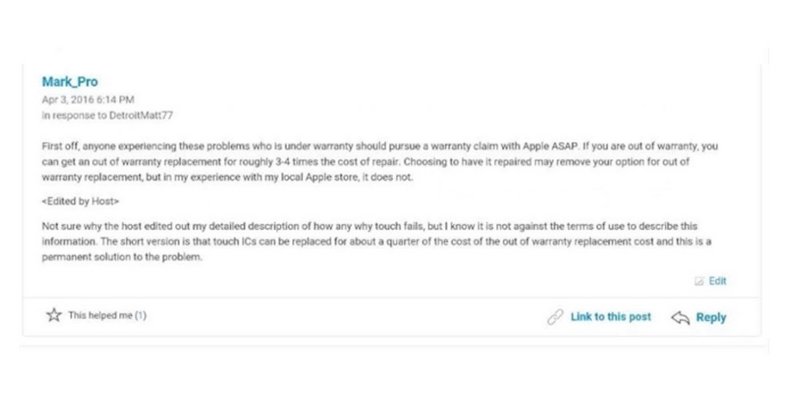
The gray flickering bar you can see across the top of this iPhone is a classic symptom of a problem that repair pros are seeing in more and more iPhone 6 and 6 Plus devices.
Posted on 08/23/2016 1:48:10 PM PDT by Swordmaker
People all over the world mail their broken iPhones to microsoldering specialist Jessa Jones. Aided by powerful microscopes and precision soldering irons, experts like Jessa pluck tiny chips off logic boards, swap them for new ones, and resurrect devices over which Apple’s Genius Bar would say a eulogy.
Jessa can fix practically anything. But these days, she spends most of her time fixing just one thing. Because every single month, more and more iPhone 6 and (especially) 6 Plus devices show up at her shop, iPad Rehab, with the same problem: a gray, flickering bar at the top of the display and an unresponsive touchscreen.

The gray flickering bar you can see across the top of this iPhone is a classic symptom of a problem that repair pros are seeing in more and more iPhone 6 and 6 Plus devices.
Turns out, Jessa’s not alone. Lots of repair pros are experiencing the same influx of faulty iPhones—most with flickering gray bars and all with glitchy touch functionality. Rami Odeh, a repair tech from New Orleans, sees up to 100 iPhone 6 and 6 Pluses a month that don’t respond well to touch. About half of the repairs sent to Michael Huie—the specialist behind Microsoldering.com—show symptoms of the same problem.
Of course, there’s no way to tell exactly how many phones are afflicted with what we’re calling Touch Disease, but every repair tech we spoke to told us that the problem is incredibly common.
“This issue is widespread enough that I feel like almost every iPhone 6/6+ has a touch of it (no pun intended) and are like ticking bombs just waiting to act up,” says Jason Villmer, owner of STS Telecom—a board repair shop in Missouri. He sees phones like this several times a week.
If pages and pages of complaints on Apple’s support forum are any indication, Apple’s aware there’s a hardware issue with the iPhone 6 and 6 Plus—but they aren’t doing anything about it.
“I took [my phone] to the ‘Geniuses’ at Apple Store in Westfield Valley Fair mall (Santa Clara, CA),” one iPhone 6 Plus owner wrote on Apple’s support forum. “After a very long wait (~2 hrs) I finally met with a rep. He acknowledged the problem (he was very familiar with it), but said Apple doesn’t recognize it as an issue, and so there is not much he can do.” Another iPhone 6 Plus owner was apparently told by an Apple employee that people come in with this issue “several times per day.” “After talking to a tech, I got exactly what I expected ‘You’re out of warranty and you’re [sic] only option is to buy a new phone,” the user wrote.
Despite Apple’s white flag, some afflicted users have noticed that strategically twisting the phone a bit or putting pressure on the screen reverses the issue for a while. The gray flickering bar goes away. After a short remission, though, the iPhone illness gets worse. The insidious gray bar of death spreads. Touch functionality gets increasingly glitchier. Eventually, the phone loses touch completely.
Here’s where the plot thickens: Replacing the touchscreen doesn’t fix the problem. The gray bar eventually shows up on the new screen, too. Because, according to repair pros, the problem isn’t the screen at all. It’s the two touchscreen controller chips, or Touch IC chips, on the logic board inside the phone.

These two Touch IC chips—known as the U2402 Meson and Cumulus U2401 chips, as Apple refers to them—are the root cause of the touch epidemic repair pros have been seeing in the iPhone 6 and 6 Plus. Here they are pictured in the iPhone 6.
These two chips translate your finger mashing on the display into information your phone can actually use. When the Touch IC chips go bad, you can jab, tap, and poke the screen all you want—your phone can’t correctly process the information. At least, not until the bum chips are replaced with new ones.
Apple’s repair Geniuses aren’t equipped to make specialized repairs to the logic board in-house, so they can’t actually fix Touch Disease. But skilled, third-party microsoldering specialists (most “unauthorized” to do Apple repairs, according to official company policy) can fix phones with symptoms of Touch Disease. And they can do it a whole lot cheaper than the cost of a new logic board or an out-of-warranty phone replacement. Which is precisely why so many of these damaged iPhones are finding their way into repair shops around the world.
A photo posted by Jessa Jones (@ibjessa) on Jul 27, 2016 at 8:10pm PDT
“The issue is ridiculously widespread and Apple should’ve issued a recall or maybe a free warranty repair on this problem already,” Huie told me via email. “If you own an iPhone 6+ and haven’t experienced the problem yet, then I think the chances are pretty high that you’ll experience it during the lifetime of the phone.”
After fixing hundreds of broken iPhone 6 and 6 Pluses, many pros have developed theories about what causes Touch Disease in these two specific models. One microsoldering pro I spoke to speculated that the U2402 Meson chip—one of the two Touch IC chips on the board—has a manufacturing defect. But the most popular theory I heard is that Touch Disease is the unanticipated, long-term consequence of a structural design flaw: Bendgate.
Back when the iPhone 6 and 6 Plus were first released, some owners discovered that the large, wide phones had a nasty habit of molding themselves to the shape of your rump if left too long in a back pocket. The phenomenon, known as Bendgate, was ostensibly put to bed when Apple apparently strengthened weak points in the rear case of the iPhone 6s.
“But the fact remains—compared to earlier iPhone models, the iPhone 6/6+ is kind of a ‘bendy’ phone. Its slim form factor and larger surface area subject the logic board within the phone to mechanical flexion pressure that no other iPhone has had to deal with,” Jessa explains in a detailed blog post. The iPhone 6 Plus—the wider of the two phones—appears to be especially susceptible to this kind of damage.
In both the iPhone 6 and 6 Plus, the Touch IC chips connect to the logic board via an array of itty-bitty solder balls—“like a plate resting on marbles,” Jessa explains. Over time, as the phone flexes or twists slightly during normal use, those solder balls crack and start to lose contact with the board.
“At first, there may be no defect at all. Later you might notice that the screen is sometimes unresponsive, but it is quick to come back with a hard reset,” Jessa explains. “As the crack deepens into a full separation of the chip-board bond, the periods of no touch function become more frequent.” Any drops or heavy handling keep chipping away at the cracked solder balls. Damage enough of them, and the connections between the chips and the logic board are severed, signals are lost, touch gets glitchier, and then goes away altogether.
Of course, the iPhone 6s and 6s Plus are also big phones—so why doesn’t Touch Disease happen to them, too? It turns out that size matters—but it’s not the only thing that matters. In the iPhone 6s/6s Plus, Apple moved the susceptible Touch IC chips off the logic board and onto the display assembly, presumably sheltering them from most of the flexing forces the logic board is subjected to.
And repair professionals have singled out other problematic design elements of the iPhone 6 and 6 Plus. In other phones, a little blob of cured “underfill” beneath critical chips helps to keep solder balls secure—but there’s no underfill anchoring Touch IC chips to the board in the iPhone 6 and 6 Plus. In previous iPhone models, Apple also covered the Touch IC chips with a rigid, metal EMI shield. In the iPhone 6 and 6 Plus, the rigid shield was replaced with a pliable sticker shield.
“Since the Touch IC chip doesn’t have underfill, nor a metal backing, it seems to be the first to ‘break off’ the logic board,” Huie explains. “When I say ‘break off,’ I mean the solder joints break off from the chip, which causes the no touch.”
So what do you do if you see a gray, flickering bar at the top of your iPhone 6 or iPhone 6 Plus? That twisting trick we mentioned earlier? Turns out putting pressure on the screen allows the chip to make full contact with the board again, Jessa explained. But it’s not a permanent fix. It’s a bandaid—and a poor one, at that (don’t break your phone trying to fix it, please). The only permanent fix is to replace the phone (expensive), replace the logic board (also expensive), or replace both Touch ICs on the board (less expensive).
Watch our interview with Jessa to learn more:
So, if you’re experiencing symptoms of Touch Disease and you’re still in warranty—now might be a good time to take advantage of that warranty replacement option. Though, there’s no guarantee that your replacement phone won’t suffer from the same issue somewhere down the line, too.
If you’re out of warranty, you can take your phone to an electronics repair shop that offers board-level repairs. A good microsolderer can replace those two Touch IC chips on the iPhone’s logic board for less than the price of a new phone. (Make sure the shop you choose replaces the chips, and doesn’t just reflow them, warns Jessa. Reflowing—or heating up the chips until the solder melts and reconnects to the joint—doesn’t fix the loss of touch in the long run. The problem tends to come back.)
In order to ensure that Touch Disease is actually cured, some repair shops have been experimenting with ways to keep the logic board from flexing. After a Touch IC repair, iPad Rehab, for example, has been adding a strong metal shield over the top of the chips as an internal reinforcement.
“We have found that placing our own mod—a metal shield soldered over the sticker shield—seems to protect the phone from future recurrence of the problem. We (and others) have only recently started sending out our Touch IC jobs with the ‘futureproof’ shield on them,” Jessa says. So far, she says, none of her customers have reported any adverse effects from the hardware mod.
Of course, no option involving independent repair would be endorsed by Apple. In fact, Jessa and colleague Mark Shaffer have been censored and banned from posting on Apple Support Communities for explaining why touch fails and suggesting third-party repair as a solution.

Repair pro Mark Shaffer’s post on Apple Support Community before it was edited by a mod.

And after.
So it seems like Apple is happy to sell people replacement phones, but they seem unwilling to point iPhone owners to the only people who can actually fix the problem: independent repair shops.
“[Apple doesn’t] tell customers they can get it fixed at an independent service center. They don’t offer repair of it at all. The only option that Apple offers to people who encounter this problem is ‘Would you like to buy a new iPhone?” says Louis Rossmann—a board repair expert from New York City—in a YouTube video on the topic.
Rossmann predicts that, eventually, the Touch Disease problem will probably explode into a class action lawsuit—at which point Apple will be forced to respond with some sort of extended warranty program. But only if customers start banding together and demanding more support from Apple for this problem.
If you’ll remember, it took an exposé and a massive public outcry for Apple to address Error 53—and that was a comparatively easy-to-fix software issue. Touch Disease is a hardware problem; Apple can’t fix this thing with an iOS update. Addressing Touch Disease is going to be more complicated, and more costly. But if the issue is as widespread as repair pros suspect, then Apple should start offering customers solutions instead of excuses. And they need to do it soon.
“Apple has designed phones better than this in the past. They need to design phones better than this in the future,” says Rossmann. “And they need to take accountability and responsibility for the devices that people have been paying for right now that don’t work the way they’re supposed to.”
It is my understanding that these automobile recalls are for problems that can cause life threatening injuries or even death. iPhones don't normally cause this kind of mayhem.
If Siri doesn't pronounce your name properly, you just tell her how you want her to pronounce your name and she will pronounce it that way from then on. That article was stupid. I can see that perhaps for a celebrity it might be necessary to add the correct pronunciation to Siri's data base so that Siri will ALWAYS pronounce "Bar-BRA" and not say "Bar-Bar-ah" in the normal way it is usually pronounced, but it is not a big deal.
As for "AntennaGate", there never was a problem with the antenna on the iPhone 4 (and Apple never told "folks" to hold their iPhones differently. That was a single email to one user from Steve Jobs in a joke.) The fact was that EVERY cellular phone will attenuate if you cover the antenna with your hand! Apple showed that every single cellular phone maker's manual had instructions showing the correct way to hold their phones, demonstrating that the user was NOT to cover the area where their antennas were located, usually with a red circle with a bar through the image of the user holding it that way. In fact, several technical labs tested every cellular phone and found that Apple's iPhone 4 attenuated LESS than every other phone on the market at that time when you placed your hand on the antenna. They also found that the iPhone was the most sensitive of the phones on the market and could both receive weaker signals that others could not, and was capable of sending stronger signals when covered than others due to the antenna not being inside the phone. "AntennaGate" was purely a marketing creation of Samsung and Google to push Samsung's newest Google Android phone.
The dropping of the signal associated with the iPhone occurred only on ONE carrier, AT&T, and only in areas where AT&T was oversold and could not service the new customers they were getting from Apple with the number of towers they had, or on the periphery of their areas. . . which is funny, because the iPhone in question could still get a signal where all the other cellular phones could not!
When Apple released that SAME, IDENTICAL iPhone to the rest of the world without modifying a thing, i.e. same antenna, the rest of the world had ZERO PROBLEMS with it. No dropped calls, no claims of loss of signal, no breathless stories about problems. Why? Because there was no marketing campaign going on from Samsung/Google.
Samsung expended $14 billion for marketing that year, but only $4.5 billion of that was for advertising expense. Over $9 billion was for social marketing, FUD!
As for fixing "problems for the proles", I have experienced taking a friend to the Genius bar with a two year out of warranty MacBook Pro that was not working properly. The Genius there came back and said they had determined they could not fix it and had decided it needed to be replaced. . . and laid a brand new MacBook Pro on the counter. My friend protested "I can't afford to buy a new one!"
The Apple guy, said, "Don't worry. It's no charge! Give us an hour so we can copy over your data for you. We will erase the data on your old hard drive. Do you want to witness us do that?"
An hour later we walked out with her brand new, $2500 MacBook Pro with a lot more RAM, fully set up, and all of her data intact on the new larger hard drive. . . than the broken system she walked in with, free of charge. With a new warranty!
So much for your "They won't fix it" meme.
So, you're carrying it wrong? Sorry, couldn't resist... :)
Steven Jobs, you are missed.
Sure. Please cite the event. What auto recall could NOT be traced to a specific item, MFG date, serial etc. where they were EVER forced to recall every car manufactured by a auto manufacturer. You claim you were there and did that. So tell us. What car, what manufacturer. . .
The only one i can think of was the deliberate fraud from VW on their smog certification testing, and that doesn't meet the requirement. Even there it was specific models and years and serial numbers, not all of their cars.
I truly am a Luddite, I’m still using a Nokia 3585 that I got at the turn of the century.
They never fail.
From the numbers I am seeing, calculated on the total number of iPhone 6/6plus sold, less than 0.05% for this problem. The average failure rate for most phones is around 3.7% from all causes, not counting broken or cracked screens. The Apple rate is around 2.4% not counting broken or cracked screens. This isn't even a nose pimple on that body of failures for that model of iPhones.
Interesting article from an Android centric website on the comparison of failure rates of all Android phones v. all iPhones over the lives of those cellular phones:
Android phones failed at higher rates than iPhones in Q1, study shows, these are the worst offenders
13 May 2016, 05:06, by Daniel P.
Source — PhoneArena.comAndroid phones failed at higher rates than iPhones in Q1, study shows, these are the worst offenders.
Android phones have been flooding the world for the last couple of years in all shapes, sizes and price points, so there is little wonder that they are failing at higher rates than the pricey, limited iPhone editions. Still, the latest phone failure rates study from the Blanca Technology Group comes to draw that conclusion in the form of a nice graph, so no complaints.
What the research firm found out is that the failure rate for Android devices was 44 percent, compared to 25 percent for the iOS-driven gear. Moreover, further analysis shows which Android phones have broken down most often in the previous quarter. That would be a few former Samsung flagship editions - S6, S5 and S6 Active - again no wonder, given how popular they are, but the Lenovo K3 Note sticks like a sore thumb in this graph, indicating some underlying problems with the handset. Ditto for the 3rd generation of the Moto G.
These two are budget handsets, so the failure rate of Samsung's mid- and high-end phones would be more concerning. Until you look at the actual percentage of failed units, that is - the 6-7% tally can hardly be called alarming. Unless you are in the failed device owner category, that is. As for Apple, out of the 25 percent of failed iOS devices for whatever reason, it's the iPhone 6 and the iPhone 5s models with the highest mishap rates, or those with the largest ownership base among iPhone fans.
Semaphore flags here..... old school is still school.
Rolling on the floor laughing my tin whiskers off!
Nope, Good one, that is funny.
Old school indeed. Can't remember any of it from scouting days. Only really used it once for badge after much practicing. Scout master, Korean War Marine vet. had our little troop positioned for a message relay back to him. Will never forget the message though, "chinks crossg yalu"
The tin whiskers may actually be the modality of failure at work here, Bobalu. It would explain all of the symptoms. Whiskers growing from both directions across such small gaps will, occasionally touch under both minor flexing and also under heat expansion resulting in intermittent shorting of the IC connections. It would explain the flashing, irregular grey bar. Arcing, even at micro voltages and amperages,acts like that as it connects and breaks the connection.
That’s pretty common. My wife’s 6 S plus locks up at least once a day, but it looks good. We just reboot.
Usually happens after a phone call.
A co-worker received a new company iPhone 6 a few months ago. Today he was prompted when he plugged it into iTunes to update. It failed. He was told to restore the device but that too failed. Tried a hard reset by holding down the Home + sleep/wake buttons but after seeing the apple logo it went back to the screen he started at.
Kinda annoying. Many people posting the same problem. No answer yet. He may end up with a new phone.
LMAO.... thats were I got my merit badge as well...... good skills retained from scouting, used throughout my life.
Stay Safe !
That's only true when the defect involves safety of the vehicle. "Customer satisfaction" defects are not required by the government. Of course, they are covered by warranties that last far longer than the warranties Apple phones have.
I look forward to the class action lawsuit. I was told (after two hours sitting at Apple WITH a Genius Bar appointment) the phone was un-repairable.
“Semaphore flags here..... old school is still school.”
I was a Morse Op, but that was 35 years ago. I’m still good unless you throw in special characters.
Great advice - thanks.
Disclaimer: Opinions posted on Free Republic are those of the individual posters and do not necessarily represent the opinion of Free Republic or its management. All materials posted herein are protected by copyright law and the exemption for fair use of copyrighted works.